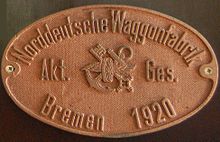Wagon construction Bremen
The history of wagon construction in Bremen began in the 1880s with the Walle wagon construction company of the Great Bremen Horse Railway and ended in 1995 with the bankruptcy of Bremer Waggonbau GmbH .
Wagenbauanstalt Walle
The Walle Wagenbauanstalt was operated by the Great Bremen Horse Railroad to manufacture horse-drawn railroad cars on the one hand for its own needs, but also on behalf of other companies. So were u. a. also built vehicles for the rival company, the Bremer Pferdebahn . A car built in 1888, which was rediscovered as a gazebo in 2007 and is to be restored again, has been preserved to this day.
North German wagon factory
In 1908, merchants and industrialists like Sigmund Meyer founded the Norddeutsche Waggonfabrik (also called Nordwaggon ) in Bremen-Hastedt together with a Remscheid steel company and the Bremen tram . The first delivery consisted of 40 tram cars for the just electrified Bremerhaven tram . In addition to trams and a. also railcars for main and branch lines, passenger cars, freight cars , mail cars and refrigerated cars. Deliveries were made to trams and railways in Germany, the Netherlands, Sweden, Finland, Denmark, Poland and Argentina. In 1925 the company was converted into a stock corporation. Economic crises and the associated decline in orders led to the takeover by the Linke-Hofmann wagon factory in Breslau in 1929 . In 1930 the factory was closed. In March 1934, Borgward acquired part of the halls in order to produce Hansa 1100 automobiles there . From 1935, Focke-Wulf also built military aircraft in the hangars. Some of the wagons from the Norddeutsche Waggonfabrik have been preserved in museums to this day.
Hansa Waggonbau
In 1946, Hansa Waggonbau GmbH was established at the same location . At first they began to repair road and rail cars damaged in the war, later new vehicles were built. The delivery program mainly included trams, passenger cars, dining and sleeping cars, mail cars and freight cars. The best-known vehicles include the universal sleeping cars of the U-Hansa type (1957), the first prototypes of the n-cars (1958) and parts of the later series delivery, as well as the short-articulated tram cars of the GT4 type (1959), the principle of which continues to this day Wagon building industry is applied. Diesel multiple units such as the two-axle T2 of the Grafschaft Hoya public transport company were built for private railways in 1954 .
Declining orders forced the company to look for new fields of activity in the 1970s. Among other things, ship equipment and containers were built. Plans for a housing estate in container construction were developed. In 1973 the GmbH was converted into a stock corporation, but had to file for bankruptcy in 1975 .
Bremer Waggonbau
The only cost-covering area, the repair of railway wagons, was continued as Bremer Waggonbau GmbH . Wagons for the German Federal Railroad and the British and American Army as well as trams from Cologne and Bremen were overhauled. They specialized and earned a good reputation in the restoration of high-quality passenger coaches, including for museum railways . The decline in orders from the British Army led to the company's bankruptcy. The history of wagon construction in Bremen ended with eleven newly built wagons for the Langeooger Inselbahn in 1995. Today there is a scrap recycling company on the factory premises.
Individual evidence
- ^ Horse-drawn tram 23 Friends of the Bremen Tram eV
- ^ Hans Christoph Graf von Seherr-Thoß: Sigmund Meyer (called Hans Sigismund). In: New German Biography (NDB). Volume 17, Duncker & Humblot, Berlin 1994, ISBN 3-428-00198-2 , p. 373 f. ( Digitized version ).
- ^ Paul Homann: VGB-Nachrichten. P. 312; Date: Friday, February 23, 2007 , accessed March 30, 2019 .
- ↑ Tram car offered by the City of Helsinki in 2018 from 1923-1925
- ↑ On the move with wagons from Bremen (PDF; 582 kB) Deutsche Bahn
- ↑ Rolf Löttgers: The narrow-gauge railway time in color . Franckh'sche Verlagsbuchhandlung, Stuttgart 1983, ISBN 3-440-05235-4 , p. 100 .

